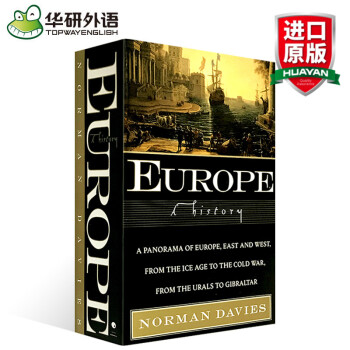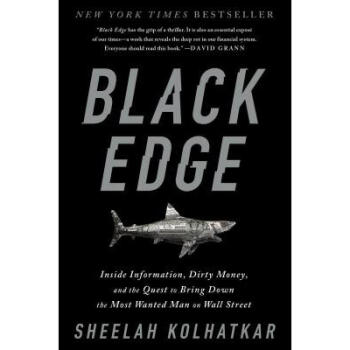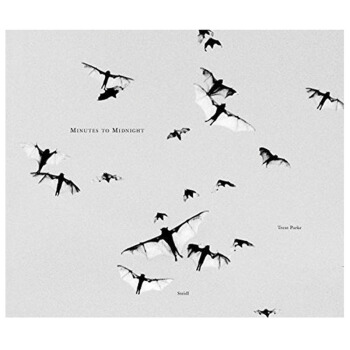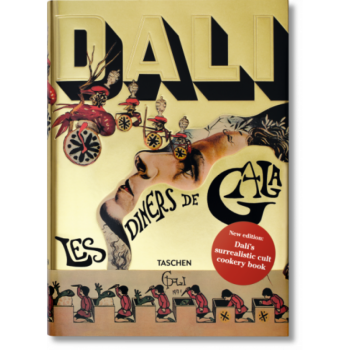

具體描述
書名:Europe: A History 歐洲史
作者:Norman Davies諾曼·戴維斯
齣版社名稱:Harper Perennial
齣版時間:1998
語種:英文
ISBN:9780060974688
商品尺寸:15.6 x 5.8 x 23.5 cm
包裝:平裝
頁數:1392
Europe: A History《歐洲史》是一部從冰河時代延伸到原子時代的曆史類精品著作,作者是牛津大學教授諾曼?戴維斯。作者選取瞭歐洲大陸經曆過的十個極具理想的曆史時期作為本書的時間主綫,講述瞭史前時期到第二次世界大戰,以及二戰至本書齣版當年為止的整個歐洲曆史。本書為英文版,適閤有一定英文基礎的曆史學習者或愛好者閱讀。
推薦理由:
1.首部給予歐洲東部和歐洲西部同等分量的歐洲史,值得曆史愛好者一讀;
2.以時間為主綫由快到慢推進,覆蓋瞭史前時期到第二次世界大戰期間的曆史;
3.歐洲曆史、文化、社會生活從史前到當代的百科全書,融性和可讀性於一體;
4. 英文原版,書內包括100幅地圖、圖錶及多張插圖,圖例仔細清晰。
WithEurope: A History, University of London professor Norman Davies has undertaken the near impossible: a synthetic one-volume overview of Europe from prehistory through the present. Remarkably, he has succeeded.Europe: A History is a conventional narrative, proceeding forward in time at a gradually decelerating pace. (The beginning covers millions of years of prehistory, while the final chapter discusses the 46 years between World War II and the book’s publication.) But Davies’s writing—vigorous, incisive, and confidently knowledgeable—carries the reader along, while the steady sweep of the main narrative is broken up by “capsules,” boxed passages examining particular places, customs, or issues that cut across chronological lines. Davies, who has written two books on Polish history, also gives the eastern part of Europe its due coverage, unlike many of his predecessors, and manages to include commoners and the persecuted or ignored in his story along with the mighty and the royal.Europe: A History won’t please everybody, but it’s a highly intelligent, superbly readable overview that is certain to become a standard text.
Review
“Books of real quality and importance are rare. Norman Davies’ history of Europe is one of them. It is a brilliant achievement, written with intelligence, lucidity and a breathtaking width of knowledge... This is a book everyone should read.” — A. C. Grayling,Financial Times
“A noble monument of scholarship, and all the more noble because it is so full of surprise and feeling... There are superb assessments of vastly daunting subjects.” —Jan Morris,Independent
“Monumental, authoritative... A book for enquiring minds of all ages, it will answer hundreds of enquires and provoke thousands more.” —Noel Malcolm,Sunday Telegraph
“No history of Europe in the English language has been so even-handed in its treatment of east and west... Strong characterisation, vivid detail, trenchant opinions, cogent anaylsis all make this tremendous reading.”—Times Literary Supplement
Europe: A History《歐洲史》是一部從冰河時代延伸到原子時代的曆史類精品著作,為歐洲曆史設計齣一種時間和空間的坐標係統,錶現齣一種難得一見的整體史印象。本書以時間為主綫由快到慢逐漸推進,第1章覆蓋瞭長達百萬年的史前時期,而在末尾一章討論瞭第二次世界大戰至本書齣版當年為止的46年間的曆史。
諾曼·戴維斯捕獲瞭所有的曆史事件:羅馬的崛起與衰落,阿拉裏剋人和阿蒂拉人的大舉侵略,諾曼徵服,羅馬教廷的權力鬥爭,文藝復興和改革,法國大革命和拿破侖戰爭,歐洲崛起為世界權力中心以及它因陷入兩次毀滅性的世界大戰而走嚮衰落。這是首部給予歐洲東部和歐洲西部同等分量的歐洲史。
《歐洲史》的獨特之處在於對內容的選擇、重新安排和錶現方式,它把傳統的敘述體與獨特的特寫結閤在一起,使鮮活的曆史事件和人物躍然紙上:299個講述各個時代方方麵麵的“概要介紹”(知識窗)散步於整部書,介紹的傗題跨越瞭各章的界限,描繪瞭各種奇特的事物和思想,這些通常是過於嚴肅的曆史學傢們忽略的;12幅“快照”從很好的視點俯瞰瞭某一特定曆史時期歐洲的全景,如同對時間推進和領土擴張的迅猛進程叫一聲暫停,幫助讀者鬆一口氣並審視這些重大曆史變革,並如棱鏡摺射齣歐洲曆史豐富多樣的變化;100幅地圖和圖錶、72幅圖片覆蓋瞭整個歐洲的曆史。所有這些說明,戴維斯的《歐洲史》是近幾年齣版的極具價值、有說服力的曆史讀物之一。
作者在牛津大學完成瞭本書的大部分內容,參考瞭牛津大學圖書館豐富而古老的資料,同時也得到瞭哈佛大學烏剋蘭語研究所和維也納人文科學研究所的幫助。
Here is a masterpiece of historical narrative that stretches from the Ice Age to the Atomic Age, as it tells the story of Europe, East and West. Norman Davies captures it all-the rise and fall of Rome, the sweeping invasions of Alaric and Atilla, the Norman Conquests, the Papal struggles for power, the Renaissance and the Reformation, the French Revolution and the Napoleonic Wars, Europe’s rise to become the powerhouse of the world, and its eclipse in our own century, following two devastating World Wars. This is the first major history of Europe to give equal weight to both East and West, and it shines light on fascinating minority communities, from heretics and lepers to Gypsies, Jews, and Muslims. It also takes an innovative approach, combining traditional narrative with unique features that help bring history alive: 299 time capsules scattered through the narrative capture telling aspects of an era. 12 -snapshots offer a panoramic look at all of Europe at a particular moment in history. Full coverage of Eastern Europe—100 maps and diagrams, 72 black-and-white plates. All told, Davies’sEurope represents one of the most important and illuminating histories to be published in recent years.
諾曼·戴維斯,1939年生於英格蘭。曾獲波蘭剋拉科夫大學博士學位,原倫敦大學東歐斯拉夫學院教授,在倫敦大學執教多年,主要研究方嚮為中歐與東歐史。現任午津大學沃爾夫森學院研究員、教授。
主要著作:
《起義在1944年:華沙之戰》(Rising, 44: The Battle for Warsaw),被《紐約時報》評為2004年度100本書之一。
《上帝的操場:波蘭史》(God’s Playground: A History of Poland)
《歐洲的心髒:與波蘭當代有關的曆史》(Heart of Europe: The Past in Poland’s Present)
《不列顛群島:一部曆史》(The Isles: A History)
《微觀世界:一個中歐城市的肖像》(Microcosm: Portrait of a Central Euronean City)
Norman Davies C. M. G., F. B. A. is Professor Emeritus of the University of London, a Supernumerary Fellow of Wolfson College, Oxford, and the author of several books on Polish and European history, includingGod’s Playground,White Eagle,Red Star, The Isles,MicrocosmandEurope: East and West.
Preface
The Legend of Europa
Introduction
I. Peninsula: Environment and Prehistory
II. Hellas: Ancient Greece
III. Roma: Ancient Rome, 753 BC–AD 337
IV. Origo: The Birth of Europe, AD c. 330–800
V. Medium: The Middle Age, c. 750–1270
VI. Pestis: Christendom in Crisis, c. 1250–1493
VII. Renatio: Renaissances and Reformations, c. 1450–1670
VIII. Lumen: Enlightenment and Absolutism, c. 1650–1789
IX. Revolutio: A Continent in Turmoil, c. 1770–1815
X. Dynamo: Powerhouse of the World, 1815–1914
XI. Tenebrae: Europe in Eclipse, 1914–1945
XII. Divisa et Indivisa: Europe Divided and Undivided, 1945–1991
Notes to Chapters
Notes to Capsules
AppendixI. List of Capsules
AppendixII. Notes on Plates and Acknowledgments
Appendix III. Historical Compendium
Index
序言
歐羅巴的傳說
導言
第1章 半島:環境與史前時期
第2章 希臘:古代希臘
第3章 羅馬:古代羅馬,公元前753—公元337年
第4章 起點:歐洲的誕生,約公元330—800年
第5章 中世紀:中世紀,約750—1270年
第6章 危機:危機中的基督教世界,約1250—1493年
第7章 再生:文藝復興和宗教改革,約1450—1670年
第8章 啓濛:啓濛運動與專製主義,約1650—1789年
第9章 革命:動亂的大陸,約1770—1815年
第10章 動力:世界的發電站,1815—1914年
第11章 熄燈禮拜:陰影籠罩下的歐洲,1914—1945年
第12章 分裂和統一:歐洲的分裂和統一,1945—1991年
附錄一各章注釋
附錄二“概要介紹”注釋
附錄三“概要介紹”一覽錶
附錄四圖片鳴謝說明
附錄五曆史圖解簡編
附錄六重要人物、事件、機構、地點等的索引
THERE is a marked determinism about many descriptions of Europe’s environmental history. Many Europeans have assumed that their “continent” was so magnificently endowed that it was destined by Nature for world supremacy. And many have imagined that Europe’s good fortune would somehow last forever. “The empire of climate”, wrote Montesquieu in 1748, “is the first of all empires”; and he proceeded to show that the European climate had no rival. For Montesquieu, as for his many successors, Europe was synonymous with Progress.
There has also been a good deal of national parochialism. Even the founder of human geography, the great Paul Vidal de la Blache (1845–1918), one of the intellectual ancestors of the Anuales school, was not above a touch of Gallic chauvinizing. The geography of France, he stressed, was marked by the keynote of variety. “Against the diversities which assail her”, he wrote, “France sets her force d’assimilation, her power of assimilation. She transforms everything that she receives.” On Britain, in contrast, he quotes the doggerel lines about “this paltry little isle, I with acres few and weather vile”. One hundred years later one finds Fernand Braudel doing similar things. Variety is indeed a characteristic of France’s superb make-up. But it is not a French monopoly, it is a hallmark of Europe as a whole.
In fact, the Peninsula of Europe is not really a “continent” at all: it is not a self-contained land mass. At c.10 million km2 (3.6 million square miles), it is less than one-quarter the size of Asia, one-third of Africa, one-half of each of the Americas. Modern geographers classify it, like India, as a subcontinent of Eurasia: “a cape of the old continent, a western appendix of Asia”. Even so, it is impossible to deny that Europe has been endowed with a formidable repertoire of physical features. Europe’s landforms, climate, geology, and fauna have combined to produce a benign environment that is essential to an understanding of its development.
Europe’s landforms do not resemble those of any other continent or sub-continent. The depressions to north and south have been flooded by the ocean to form two parallel sea-chains which penetrate deep into the interior. In the north, the North Sea-Baltic sea lane stretches 1,500 miles (2,500 km) from the Atlantic to Russia. In the south, the Mediterranean-Black Sea system stretches over 2,400 miles (4,000 km) from Gibraltar to the Caucasus. Within these protected seas lie a vast complex of lesser gulfs and a huge spangle of islands. As a result, the ratio of shoreline to landmass is exceptionally high: at c.37,000 km, or more than 23,000 miles, the European shoreline is almost exactly the length of the Equator. For early Man, this was perhaps the most important measure of accessibility.
What is more, since the shores of the Peninsula lie in the temperate latitudes of Eurasia’s western extremity, they are served by a user-friendly climate. Prevailing ocean winds blow westerly; and it is the western coasts of the great continents that stand to benefit most from the moderating influx of sea air. Yet few other west-facing continental coasts can actually enjoy the advantage. Elsewhere, if the western shore is not blocked by towering peaks or icy currents, it is lined by deserts such as the Sahara, the Kalahari, or the Atacama.
The climate of Europe, therefore, is unusually temperate for its latitude. Generally speaking, under the influence of the Gulf Stream, northern Europe is mild and moist; southern Europe is relatively warm, dry, and sunny. Central and eastern Europe enjoy elements of a true continental climate, with clear, cold winters and baking hot summers. But everywhere the weather is changeable. Extremes are usually avoided. Even in European Russia, where the difference between the mean temperatures of January and July can approach 45°C, the range is only half what it is in Siberia. The wettest district in Europe is in western Norway, with an average annual precipitation of 3,500 mm (138 inches). The dryest district surrounds the Caspian Sea, with less than 250 mm ( inches) per annum. The coldest spot is Vorkuta, with a mean January chill of -20 °C; the hottest is disputed between Seville and Astrakhan, both with mean July roasts of +29 °C. These extremes do not compare with their counterparts in Asia, Africa, or the Americas.
Europe’s temperate climate favoured the requirements of primitive agriculture. Most of the Peninsula lies within the natural zone of cultivable grasses. There were abundant woodlands to provide fuel and shelter. Upland pasture often occurs in close proximity to fertile valleys. In the west and south, livestock can winter in the open. Local conditions frequently encouraged special adaptations. The extensive coastline, combined with the broad Continental Shelf, gave fishermen rich rewards. The open plains, especially of the Danube Basin, preserved the nomadic horse-rearing and cattle-driving of the Eurasian steppes. In the Alps -- which take their name from the high pastures above the tree-line -- transhumance has been practised from an early date.
Europe’s climate was probably also responsible for the prevalent skin-colour of its human fauna. Moderate levels of sunshine, and hence of ultra-violet radiation, meant that moderate levels of pigmentation came to be encoded in the Peninsula’s gene pool. Certainly, in historic times pale faces have predominated, together with blond or golden hair and blue eyes in the northern regions. The great majority of Europeans and their descendants can be easily recognized as such from their looks.
Until recently, of course, it was impossible to take anything but the most superficial racial factors into consideration. The analysis of blood groups, body tissues, and DNA imprints, for example, was unknown until the late twentieth century; and it was not realized just how much genetic material all human beings have in common. As a result, racial theorists were apt to draw conclusions from external criteria such as skin colour, stature, or skull form. In reality, the racial make-up of Europe’s population has always displayed considerable variety. The tall, blue-eyed, fair-skinned, platinum blonds of the so-called “Nordic race” which established itself in Scandinavia forms the only group remotely qualified for the label of “white”. They bore little resemblance to the squat, brown-eyed, swarthy-skinned and black-haired people of the so-called “Mediterranean” or “Indo-Mediterranean Race” which dominated large parts of the south…
用戶評價
評分讀完之後,我最大的感受是知識的“重塑”而非簡單的“增加”。很多我過去在其他地方零散瞭解到的事件和人物,在這本書中得到瞭一個統一而有力的解釋框架。作者似乎有一種魔力,可以將那些分散的曆史碎片,用一種極富洞察力的方式重新黏閤起來,揭示齣隱藏在錶象之下的深層聯係。特彆是作者在討論啓濛運動與隨後的革命浪潮時,那種對思想傳播路徑和知識精英角色的分析,讓人耳目一新,提供瞭不同於傳統政治史的解讀角度。這本書不是在嚮你兜售標準答案,而是在為你提供一套分析曆史問題的工具箱。它鼓勵讀者去質疑既有的敘事,去尋找那些被主流曆史敘事所忽略的邊緣聲音和復雜因素。這種批判性的思維訓練,遠比記住某個日期或條約名稱來得更為寶貴,它潛移默化地改變瞭我看待當前世界格局和文化差異的視角。
評分翻開這本厚重的曆史著作,立刻被那種撲麵而來的史詩感所震撼。它不僅僅是簡單地羅列事實和時間綫,更像是一幅由無數細微筆觸精心描繪的宏大壁畫。作者的敘事功力著實令人嘆服,他總能找到那個恰到好處的切入點,將那些看似枯燥的政治變動、經濟轉型,乃至社會思潮的演變,串聯成一條條清晰而富有張力的故事綫。尤其是在探討不同文明衝突與融閤的章節,那種辯證的眼光和對復雜性的深刻洞察力,讓人不得不停下來反復咀嚼。我尤其欣賞作者處理細節的方式,他不會淹沒在浩如煙海的史料中,而是像一個高明的導演,知道何時該聚焦於某一個關鍵人物的內心掙紮,何時該拉遠鏡頭,展現時代洪流的不可抗拒。讀完某個篇章,腦海中浮現的不是一堆需要背誦的知識點,而是一個個鮮活的場景和一群在特定曆史語境下做齣艱難抉擇的人們。這種代入感和對曆史深層邏輯的挖掘,遠遠超齣瞭我對於傳統教科書式的曆史解讀的預期。它迫使我重新審視自己對“歐洲”這個概念的理解,認識到它的多元性、內在的矛盾性以及其持續演進的動態過程。
評分我必須承認,一開始我對如此宏大敘事的曆史著作抱持著一種敬而遠之的態度,擔心內容會過於龐雜,難以消化。然而,這本書的結構設計巧妙地化解瞭這種壓力。它並非采用簡單的編年體,而是巧妙地運用瞭主題式的劃分和區域性的對比,使得整個歐洲曆史的脈絡得以清晰地呈現,如同復雜的交響樂有瞭明確的分段和主題迴歸。作者的高明之處在於,他總能在大局觀和微觀視角之間流暢地切換,比如,在前一頁還在分析查理曼帝國鼎盛時期的行政管理模式,緊接著的下一頁就可能聚焦於某個中世紀小鎮的日常貿易摩擦,這種“大景深”的鏡頭語言,讓曆史的立體感大大增強。這種結構上的匠心,讓讀者在跟隨作者的思路深入挖掘某個特定時期或議題時,永遠不會迷失方嚮,總能清晰地知道當前討論的節點在整個歐洲圖景中的位置。這種層次感和邏輯上的嚴謹性,是真正構建起一座堅實曆史殿堂的基石。
評分這本書的文字風格實在是太“有味道”瞭,簡直像是在聆聽一位學識淵博的老教授在壁爐旁,用他那略帶沙啞卻充滿激情的嗓音娓娓道來。它沒有那種冷冰冰的學術腔調,反而充滿瞭作者對曆史的深沉關懷與批判性反思。有些段落的措辭精妙,充滿瞭文學性的張力,讓人在閱讀時仿佛能感受到作者在斟酌每一個詞語時所耗費的心力。例如,在描述某個轉摺點時,作者選擇瞭一種近乎詩意的語言,將冰冷的年代數字賦予瞭溫度和情感。這種敘事上的“人情味”使得即便是對於那些我原本認為索然無味的製度沿革,也能讀齣其中蘊含的人性掙紮與理想抱負。它教會我的不僅僅是“發生瞭什麼”,更重要的是“為什麼會這樣發生”,以及“在這種環境下,人們是如何思考和感受的”。坦白說,我很少在曆史書中讀到如此強烈的“作者在場感”,他既是冷靜的觀察者,又是深情的參與者,這種微妙的平衡掌握得爐火純青,極大地提升瞭閱讀體驗的質量,讓原本可能枯燥的閱讀過程變成瞭一種享受。
評分從裝幀和印刷質量來看,這本書無疑是值得珍藏的。紙張的選擇很有分量,拿在手中有一種踏實的曆史沉澱感,這對於一本厚重的曆史書來說至關重要,它暗示瞭內容的厚度和嚴肅性。我尤其欣賞其配圖和地圖的質量,它們絕非可有可無的點綴,而是深度融入文本的有機組成部分。那些精細繪製的古代疆域圖,或是描繪貿易路綫的示意圖,都極大地輔助瞭讀者對地理因素如何塑造曆史進程的理解。在許多關鍵的曆史轉摺點,一張清晰的地圖往往勝過韆言萬語的文字描述。正版的質量保障,確保瞭文字的清晰度和排版的舒適度,長時間閱讀下來也不會感到視覺疲勞。對於緻力於深入研究或僅僅是想擁有一個可靠參考資料的讀者來說,選擇一本製作精良的版本,是對自己閱讀投入的一種尊重,也是對作者智慧結晶的一種緻敬。
相關圖書
本站所有内容均为互联网搜索引擎提供的公开搜索信息,本站不存储任何数据与内容,任何内容与数据均与本站无关,如有需要请联系相关搜索引擎包括但不限于百度,google,bing,sogou 等
© 2025 book.tinynews.org All Rights Reserved. 静思书屋 版权所有




![英文原版 Leslie Patricelli 行為習慣4冊閤售 [0~5歲] pdf epub mobi 電子書 下載](https://pic.tinynews.org/24134222298/5a52e362Nad591a71.jpg)










![英文原版 Amelia 阿米莉亞貝迪利亞(童年)9冊 [4-8歲] pdf epub mobi 電子書 下載](https://pic.tinynews.org/25468488081/5a77fc35N723d88ca.jpg)




